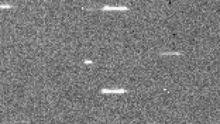WT1190F
WT1190F was an artificial object that entered the Earth's atmosphere on November 13, 2015 . It was initially assumed that this object was space junk with a size of 0.7 to 2 meters and a mass of 250 to 2000 kg. A scientific paper published in 2016 by NASA's Jet Propulsion Laboratory concluded that this part was most likely the translunar injection module (a drive component) of the space probe Lunar Prospector , which explored the moon from 1998 to 1999.
discovery
WT1190F was first discovered on February 18, 2013 by the Catalina Sky Survey Institute . Further sightings took place on November 29, 2013 and October 3, 2015. During the last sighting, it was found that the object had been seen twice and that it would burn up on November 13, 2015 when it entered the atmosphere near Sri Lanka . The re-entry parameters were unusual for space debris. The entry angle was very steep and the speed very high (11.3 km / s). This in turn enabled the very precise calculation of the entry point and time.
Observation of entry
The entrance could not be seen from the ground due to the clouds. However, the "International Astronomical Center (IAC)" and the "United Arab Emirates Space Agency" had chartered a Gulfstream G450 so that the event could be observed and documented above the cloud cover. One of the thirteen scientists on board was Peter Jenniskens from the SETI Institute , who thoroughly investigated the first predicted asteroid crash ( 2008 TC3 ). With the support of NASA, he put together the international “Next TC3 Consortium”, which deals with the discovery of impending asteroid impacts. In addition, the Ames Research Center of NASA , the Clay Center Observatory in Massachusetts, the Embry-Riddle Aeronautical University and, through ESA , the University of Stuttgart were represented by two scientists ( Stefan Löhle and Fabian Zander ).
As expected, entry took place at 06:18 UTC. The burning object could even be seen with the naked eye. The entrance was photographed and filmed in the visible and invisible spectral ranges. This event was also used to practice and improve the procedures and procedures used when an asteroid approaches Earth. In this case, determining the orbit and predicting the crash point are extremely important.
Web links
- Ephemeris from WT1190F at the IAU
- Mystery Object to Reenter Earth's Atmosphere skyandtelescope.com
- UAE Sponsors Airborne Campaign to Observe November 13 entry of Space Debris WT1190F
Individual evidence
- ↑ http://www.nature.com/news/falling-space-debris-traced-to-1998-lunar-mission-1.19162
- ↑ International Astronomical Center: UAE Sponsors Airborne Campaign to Observe November 13 entry of Space Debris WT1190F. Retrieved December 5, 2015 .
- ↑ Rapid Response to the next TC3 Consortium
- ↑ ESA: ESA sponsors WT1190F observations. October 30, 2015, accessed December 5, 2015 .
- ↑ Youtube video: WT1190F Reentry on 2015 November 13
- ↑ NASA: 'WT1190F' Safely Reenters Earth's Atmosphere, Provides Research Opportunity. November 13, 2015, accessed December 5, 2015 .

